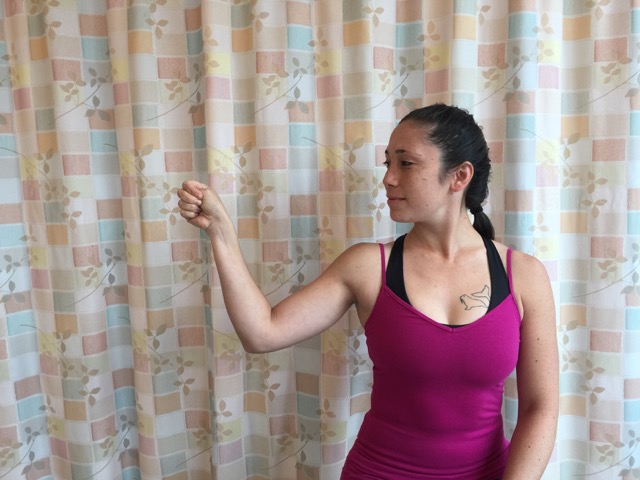Signs and Symptoms:
The signs and symptoms of De Quervain’s syndrome (De Quervain’s disease) follow from the pathophysiology. Inflammation is present and can often be visualized and palpated. This inflammation causes tenderness and therefore pain with palpation. Further, the bellies of the abductor pollicis longus (APL) and extensor pollicis brevis (EPB) are usually felt to be tight. And use of the thumb as well as ulnar deviation of the hand usually precipitate the characteristic pain at the tendon sheath near the radial styloid.
Assessment/Diagnosis:

Finklestein’s orthopedic assessment test for De Quervain’s Syndrome. Permission: Joseph E. Muscolino.
Assessment/ Diagnosis for De Quervain’s syndrome is extremely simple: a special orthopedic assessment test procedure known as Finklestein’s test is performed. The client/patient is asked to flex the thumb, enclose it by flexing fingers 2-5, and then ulnar deviate the hand at the wrist joint. This test challenges the tendons of the APL and EPB by maximally stretching them across the thumb and wrist joints. Pain during Finklestein’s test near the radial styloid confirms the presence of De Quervain’s syndrome.
Given the pathomechanics of this condition, active and passive ranges of motion that engage or stretch APL and EPB, as well as manual resistance to contraction of the APL and EPB could also be used. Active engagement of the APL and/or EPB would likely cause pain, as would a stretching force placed upon either of these muscles. Palpation can also be used to confirm the assessment. Pain with palpation is usual due to the inflammation present; and palpation of the bellies of the two muscles would likely reveal global tightness and/or myofascial trigger points.
Differential diagnosis/assessment:
Differential assessment of De Quervain’s syndrome would involve discerning if the patient’s/client’s pain and dysfunction is due to another condition of the thumb or wrist. However, a positive Finklestein’s test is considered pathognomonic, that is, it confirms the presence of De Quervain’s syndrome. Of course, a positive Finklestein’s test does not mean that the therapist should stop assessing for other conditions. Patients/clients often present with more than one condition, especially if the first condition is chronic and they have been shifting stress to other tissues via compensation patterns.


